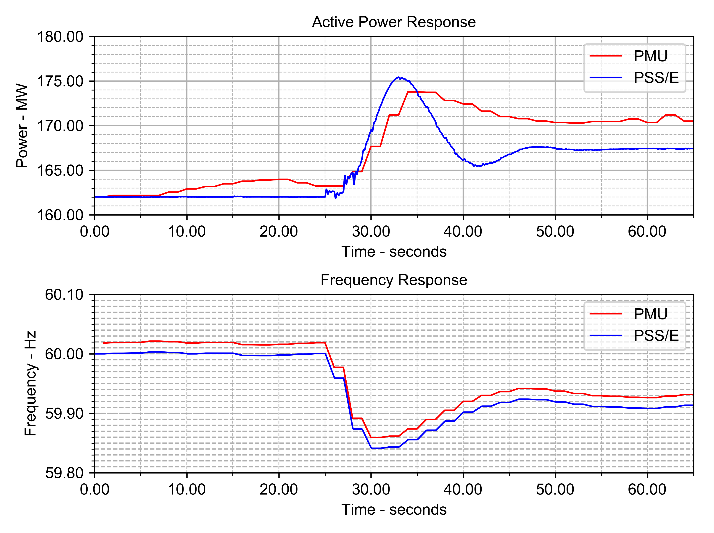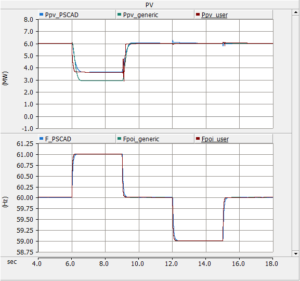By Francis Luces, Ric Austria, Cherry Bautista
(Pterra has provided support to developers on most aspects of grid interconnection, including pre-feasibility/site assessment, modeling, interconnection, and engineering design studies.)
In today’s rapidly evolving energy landscape, the reliability and efficiency of the power grid are more crucial than ever. An increasing penetration of inverter-based resources (IBR) to meet clean energy targets will also mean an IBR-dominated dynamic behavior of power systems. It is extremely important that a usable power system model representation of IBR, conventional machines, loads, and other components is submitted to utilities to support the analysis of the reliability of the transmission system.
Our Services to Meet Planning Model Submissions
Pterra offers modeling and reporting services to help conventional, or IBR plant owners comply with ISO/RTO or utility-specific interconnection application requirements and/or regulatory-mandated model submission guidelines:

Phasor-based Steady-State and Dynamic Models
PSS/E is the program used by most utilities and ISOs based in the East Coast while PSLF is used by the Western Region. Regardless of which software is being used, a usable phasor-based steady-state and dynamic model of the Plant is required for submission to aid planning engineers in their interconnection or network studies.
Oftentimes, IBRs are represented using generic dynamic models in these two well-known programs due to their simplicity. These models offer flexibility and low maintenance on larger database sets, but it is important to recognize that they have limitations. When standard models do not reflect the actual behavior of the equipment, a user-defined model (UDM) should be used and must be properly parametrized according to Project specifications.
Electromagnetic Transient (EMT) Models
Traditional use cases for electromagnetic transient simulations were insulation design, surge protection, controller design, and equipment rating adequacy studies. In the studies of IBR interconnection, EMT modeling and simulations are now needed to verify responses of IBR such as fault ride-through, P/Q priority, voltage and frequency step, phase angle jump, among others. Unlike phasor-based models, the EMT model is the closest representation of the actual equipment and controls present in the field, thus considered a high-fidelity model for system studies. ISO/RTOs have recognized the need to include PSCAD or EMTP-RV model submissions of IBRs to augment offline power system studies that were traditionally performed by phasor-based simulations.
 Model Benchmarking and Validation
Model Benchmarking and Validation
Model benchmarking is an exercise to compare model responses across different software platforms. Typically, the simulation results obtained from PSS/E and PSCAD are overlaid in one plot to allow comparison. This approach helps ISO/RTO engineers to understand model behavior and helps planning engineers to create and make better engineering solutions. The model validation is also a benchmarking effort which focuses on comparing inverter-level EMT model response against field recordings, such as those obtained from hardware in-the loop (HIL) simulations or actual measurements from grid events.
The table below shows the summary of model requirements and the corresponding references stating such requirements.
| ISO/RTO/Utility | PSSE Requirements | PSCAD Requirements | Reference Document |
| ISO‑NE | Power Flow Model | EMT Model | ISO-NE Planning Procedure 5-6 |
| Standard Model accepted | |||
| User-Defined Model not accepted | |||
| NYISO | Power Flow Model | EMT Model | Modeling Guideline for NYISO Interconnection Data |
| Standard Model accepted | |||
| User-Defined Model accepted | |||
| PJM | Power Flow Model | Developers wil be noted during TC2 Phase if a PSCAD model is needed | PJM Dynamic Model Development Guidelines for Interconnection Analysis |
| Standard Model accepted | |||
| User-Defined Model accepted | |||
| MISO | Power Flow Model | EMT Model | MISO Planning Modeling Manual v4.4 |
| Standard Model accepted | PSCAD Model Requirements Supplier Checklist | ||
| User-Defined Model accepted | BPM 015 – Generation Interconnection | ||
| SPP | Power Flow Model | EMT Model | SPP EMT Model Requirements |
| Standard Model accepted | |||
| User-Defined Model accepted | |||
| ERCOT | Collector Power Flow Template | EMT Model Template | ERCOT Dynamics Working Group Procedure Manual |
| Power Flow Model (aggregate) | EMT Model | ||
| Dynamics Model Template | |||
| Standard Model accepted | |||
| User-Defined Model accepted | |||
| SOCO | Power Flow Model | EMT Model | SOCO Model Submittal Requirements for Transmission Connected IBRs |
| Standard Model accepted | |||
| User-Defined Model accepted | |||
| TVA | Power Flow | EMT Model | TVA Modeling Requirements |
| Standard Model accepted | |||
| User-Defined Model accepted | |||
| HECO | Power Flow | EMT Model | Hawaiian Electric Facility Technical Model Requirements and Review Process |
| Standard Model accepted | |||
| User-Defined Model accepted |
Model Quality Testing
Model quality testing for IBRs in PSSE and PSCAD are a set of prescribed tests by utilities to ensure the accuracy and reliability of models submitted. Typically, the tests may include flat run, ringdown, ride-through, small step inputs on voltage and frequency controllers, and short-circuit ratio () calculations. For projects that will provide grid services or as part of power purchase agreement (PPA), additional tests such as deadband, high and low frequency disturbance, or nighttime reactive power capability are called for to demonstrate capability and compliance. Finally, new model tests such as loss of last synchronous machine (LLSM), black start capability, interaction, and phase angle jumps are being required for projects that are equipped with grid forming (GFM) control topologies such as virtual synchronous machine (VSM) or droop-based control.
NERC MOD Compliance
NERC issues a set of reliability standards, known as (Modeling, Data, and Analysis) Standards, that aim to ensure consistent modeling data reporting and validation of equipment owned by Generator Owners (GO) or Load Serving Entities (LSE). The MOD standards are:
- MOD-032-1 — Data for Power System Modeling and Analysis
- MOD-033-2 — Steady-State and Dynamic System Model Validation
- MOD-026-1 — Verification of Models and Data for Generator Excitation Control System or Plant Volt/Var Control Functions
- MOD-027-1 — Verification of Models and Data for Turbine/Governor and Load Control or Active Power/Frequency Control Functions
Typically, Transmission Planners (TP) or Planning Coordinators (PC) sends a notification to GOs and LSE for updating of power system data, model submissions, and reports of model validation against field measurements. The MOD compliance will require modeling and simulations of the Plant using phasor-based programs which can be performed by plant owners or oftentimes, third-party consultants like Pterra.
On the Model Accuracy and Usability
With the release of FERC Order 901, the accuracy of models and their usability is more important than ever to address existing and potential reliability issues associated with IBR interconnections. Our modeling efforts focus on the following key points to deliver an accurate and usable model:
- The models can be parametrized according to Project, and the model response is consistent with the field measurements.
- The parameters (e.g. control gains) applied are within the acceptable range and can be equally applied in the field.
- The models comply with ISO/RTO or utility-specific model testing requirements and quality assurance.
- The models used are not in the list of unacceptable models and represent the required control features, deadbands, and protection settings as prescribed by NERC.
Conclusions
Increasing IBRs applications results in backlogs on interconnection queues but model accuracy and usability cannot be comprised. While planning model submissions are only a small subset of a long list of interconnection application requirements, its impact to ensuring system reliability is significant.
Pterra, as a consultant, endeavors to maintain the key points mentioned above and establish collaborations with inverter original equipment manufacturers (OEM), utilities, and project developers to meet and deliver accurate, usable, and high-quality power system models.


